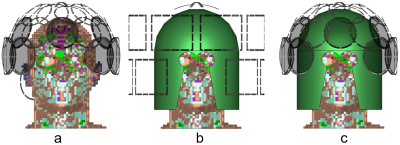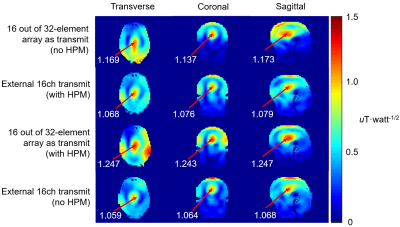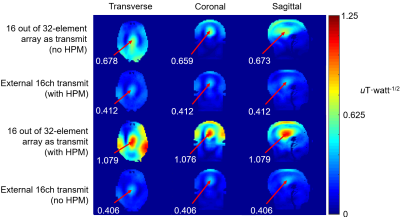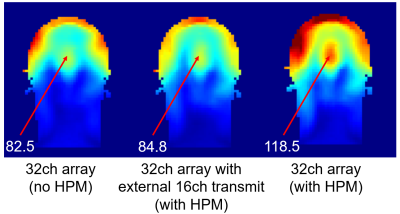1590
Performance comparison of using an external 16-channel transmit array vs. using 16 elements of a 32-channel receive array as transceivers at 10.5 T1Advanced Imaging Research Center, UT Southwestern Medical Center, Dallas, TX, United States, 2Center for Magnetic Resonance Research, Department of Radiology, University of Minnesota, Minneapolis, MN, United States, 3Department of Radiology, Pennsylvania State College of Medicine, Hershey, PA, United States, 4Department of Radiology, Stanford University, Stanford, CA, United States, 5Center for Advanced Imaging Innovation and Research (CAI2R) and Bernard and Irene Schwartz Center for Biomedical Imaging, Department of Radiology, New York University School of Medicine, New York, NY, United States, 6The Vilcek Institute at NYU Langone Health, New York, NY, United States
Synopsis
Shielding effects associated with surrounding the receive array with an external transmit (Tx) array could decrease the signal-to-noise ratio (SNR) at 10.5 T. Two Tx approaches were compared: using 16 receive elements as transceivers vs. using a 16-channel external transmit array. For both cases, the effect of using high-permittivity material (HPM) was evaluated. Our simulation results showed that performance was larger for the transceivers and further increased with HPM. This suggests that the additional complexity associated with constructing a multi-element transceiver array compared to using an external transmitter could be justified for 10.5T imaging by the expected gain in performance.
Introduction
It has been shown that the diameter of radiofrequency (RF) shield could have a significant impact on the signal-to-noise ratio (SNR) at 10.5 T [1]. The same simulation study indicated that, even when the diameter of the RF shield is optimal, shielding effects associated with an external transmit (Tx) array could decrease the SNR by up to 30% at the center of the head. In this work, we explored two alternative Tx approaches aimed at preserving SNR: using a subset of the receive elements as transceivers, and an external transmit array with high-permittivity material (HPM) between the coils and the sample. For all setups, we compared Tx efficiency and investigated how the SNR was affected.Methods
We used Microwave Studio (Computer Simulation Technology, CST, Darmstadt, Germany) and Duke [2] with 5 mm isotropic voxel size. The simulation was performed at 10.5T. The 32ch array was arranged on a holder consisting of a 240 mm-diameter half sphere and a cylinder with 240 mm diameter and 160 mm length. The array consisted of two crossed dipoles (105 mm in length and 5 mm in width) at the top of head, followed by one row of 6 loops (84 mm in diameter), a second row with 12 loops (84 mm in diameter), a third row of 10 loops (90 mm in diameter), and two additional 90 mm loops to cover the low brain stem region. For the first simulation, we used 16 elements of the 32-ch receive array as transceivers (Figure 1a). Specifically, we picked all 10 loops in the third row and every other loop in the second row. For the second simulation, we combined an 320mm-diameter external 16-ch transmit array, with an HPM helmet (relative permittivity of 50, conductivity 0 S/m, and 8 mm in thickness) between the receive array and the head model (Figure 1b). The array consisted of 15 loops and two crossed dipoles connected in quadrature on the dome. For the third simulation, we repeated the first simulation after adding the HPM helmet (Figure 1c). Finally, we repeated the simulation for the external transmit array without the HPM helmet (setup not shown in Figure 1). A 400mm-diameter gradient shield (at isocenter) was included in all the simulations. Tx efficiency, measured both as B1+ divided by the square root of absorbed power and B1+ divided by the square root of input power, was compared for the four setups. In all cases, the transmit elements were combined to create a circular-polarization (CP) mode excitation for constructive interference of central B1+. The SNR of the 32-ch receive array was also compared for the four setups.Results and Discussions
Figures 2 and 3 show Tx efficiency maps for three isocenter sections with the CP combination. There was almost no difference in Tx efficiency for the external 16-ch transmit array with/without the HPM. The performance in terms of B1+ divided by the square root of absorbed power (Figure 2) was similar in the four cases. In particular, the external 16 transmit array had longer z coverage, but approximately 8.5% and 15% lower Tx efficiency at the center of the brain, compared to the setup with 16 transceivers with/without HPM, respectively. When looking at B1+ divided by the square root of input power (Figure 3), the 16 transceivers resulted in even larger central performance relative to the other case. Specifically, it yielded 64% (without HPM) and 162% (with HPM) higher Tx efficiency at the center than the external 16-ch transmit array. The increased performance observed when adding HPM to the setup with 16 transceivers can be explained by the contribution of the auxiliary B1+ produced by the displacement currents inside the HPM. The improvement observed when normalizing by input vs. absorbed power is likely due to the lower radiation losses in the presence of the HPM [3], which enables achieving higher total B1+ with less input power, while the absorbed power remains approximately the same. The external array does not benefit from the presence of HPM because its elements are too far from the helmet. Figure 4 shows SNR maps for the 32-ch receive array. Central SNR dropped by approximately 40% with the external array (results not shown), in agreement with previous work [1]. In fact, given its enclosing cylindrical shape, the transmit array could act as a local waveguide that supports resonant modes that negatively affect SNR (e.g., by increasing the electric field within the sample) [1]. However, the SNR loss could be recovered by adding the HPM helmet (Figure 4, middle). For the transceiver setup, adding the HPM helmet increased the SNR considerably (+ 40% at the center).Conclusions
Our simulation results suggest that at 10.5T it could be advantageous to use a subset of the elements of a receive array as transceivers. Adding the HPM helmet had a negligible effect on the Tx performance of the external transmitter, but increased SNR. In the transceiver setup, the HPM improved both SNR and Tx efficiency. This work suggests that the additional complexity associated with constructing a multi-element transceiver array compared to using an external transmitter could be justified for 10.5T imaging by the expected gain in performance.Acknowledgements
The authors acknowledge the following funding:
National Institutes of Health, Grant/Award Numbers: U01 EB025144, R01 EB024536, R01 EB021277 and P41 EB017183; National Science Foundation (NSF), Grant/Award Number: 1453675; and Cancer Prevention and Research Institute of Texas, Grant Number: RR180056
References
[1] Bei Zhang, Gregor Adriany, Lance Delabarre, Jeramie Radder, Russell Lagore, Brian Rutt, Qing X. Yang, Kamil Ugurbil, Riccardo Lattanzi. Effect of radiofrequency shield diameter on signal-to-noise ratio at ultra-high field MRI, Magnetic Resonance in Medicine, DOI:10.1002/mrm.28670
[2] Christ A, Kainz W, Hahn E G, Honegger K, Zefferer M, Neufeld E, Rascher W, Janka R, Bautz W, Chen J, Kiefer B, Schmitt P, Hollenbach H P, Shen J, Oberle M, Szczerba D, Kam A, Guag J W, and Kuster N, The Virtual Family - development of surface-based anatomical models of two adults and two children for dosimetric simulations, Physics in Medicine and Biology, 55(2):N23-N38, 2010.
[3] Christopher M. Collins, Giuseppe Carluccio, Manushka Vaidya, Gillian Haemer, Riccardo Lattanzi, Graham C. Wiggins, Daniel K. Sodickson, and Qing X. Yang. Evaluation of displacement currents and conduction currents in a close fitting head array with high permittivity material. In Proceedings of the 23rd Annual Meeting of ISMRM, Toronto, 2015. P. 3103
Figures



